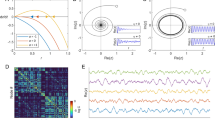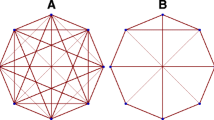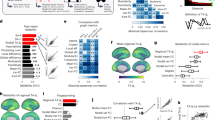Abstract
The interplay between neuronal network connectivity and neuron dynamics is known to drive global brain behavior; however, the exact relationship between network connectivity and node dynamics is complex and remains poorly understood. Previous theoretical and modeling work has shown that in small toy networks, when nodes are equipped with discrete quadratic dynamics, properties of the emergent behavior of the complex quadratic network (CQN) can give rise to features that relate to the underlying topology. Specifically, when the long-term behavior of CQNs is represented by asymptotic fractal sets, certain topological features of the fractal can be used to classify the network topology. However, the success of this approach has thus far not been tested on more complex real-world networks. Here, we apply a CQN modeling approach to capture individual differences in real-world brain networks derived from human connectome data. We show that CQNs are more sensitive than traditional graph theoretic measures at capturing individual differences in the topology of the human connectome, and that features of the associated equi-M sets can differentiate between male and female connectomes. This study, therefore, provides a basis upon which future work can build in order to better quantify individual differences in brain connectivity, and how these differences drive brain function and behavior.








Similar content being viewed by others
Data availability and materials
Data were provided [in part] by the Human Connectome Project, WU-Minn Consortium (Principal Investigators: David Van Essen and Kamil Ugurbil; 1U54MH091657) funded by the 16 NIH Institutes and Centers that support the NIH Blueprint for Neuroscience Research and by the McDonnell Center for Systems Neuroscience at Washington University.
References
Benner P, Findeisen R, Flockerzi D, Reichl U, Sundmacher K, Benner P (2014) Large-scale networks in engineering and life sciences. Springer, Birkhäuser
Porter MA, Gleeson JP (2016) Dynamical systems on networks. Front Appl Dyn Syst: Rev Tutor 4:1–91
Bullmore E, Sporns O (2009) Complex brain networks: graph theoretical analysis of structural and functional systems. Nat Rev Neurosci 10(3):186
Sporns O (2011) The human connectome: a complex network. Ann N Y Acad Sci 1224(1):109–125
Sporns O (2011) The non-random brain: efficiency, economy, and complex dynamics. Front Comput Neurosci 5:5
Sporns O (2022) Structure and function of complex brain networks. Dialogues Clin Neurosci https://doi.org/10.31887/DCNS.2013.15.3/osporns
Park H-J, Friston K (2013) Structural and functional brain networks: from connections to cognition. Science 342(6158):1238411
Fornitonito A, Bullmore ET, Zalesky A (2017) Opportunities and challenges for psychiatry in the connectomic era. Biol Psychiatry: Cogn Neurosci Neuroimaging 2(1):9–19
Korgaonkar MS, Fornitonito A, Williams LM, Grieve SM (2014) Abnormal structural networks characterize major depressive disorder: a connectome analysis. Biol Psychiatry 76(7):567–574
Erdeniz B, Serin E, Ibadi Y, Taş C (2017) Decreased functional connectivity in schizophrenia: the relationship between social functioning, social cognition and graph theoretical network measures. Psychiatry Res: Neuroimaging 270:22–31
Buchanna G, Premchand P, Govardhan A (2022) Classification of epileptic and non-epileptic electroencephalogram (EEG) signals using fractal analysis and support vector regression. Emerg Sci J 6(1):138–150
Tatarkanov A, Alexandrov I, Muranov A, Lampezhev A (2022) Development of a technique for the spectral description of curves of complex shape for problems of object classification. Emerg Sci J 6(6):1455–1475
Gray RT, Robinson PA (2009) Stability and structural constraints of random brain networks with excitatory and inhibitory neural populations. J Comput Neurosci 27(1):81–101
Siri B, Quoy M, Delord B, Cessac B, Berry H (2007) Effects of Hebbian learning on the dynamics and structure of random networks with inhibitory and excitatory neurons. J Physiol-Paris 101(1–3):136–148
Rǎdulescu A, Pignatelli A (2017) Real and complex behavior for networks of coupled logistic maps. Nonlinear Dyn 87(2):1295–1313
Rǎdulescu A, Evans S (2019) Asymptotic sets in networks of coupled quadratic nodes. J Complex Netw 7(3):315–345
Radulescu A, Evans D, Augustin A-D, Cooper A, Nakuci J, Muldoon S (2022) Synchronization and clustering in complex quadratic networks. arXiv:2205.02390
Fatou P (1919) Sur les équations fonctionnelles. Bull Soc Math France 47:161–271
Julia G (1918) Mémoire sur l’itération des fonctions rationnelles. J Math Pures Appl 8:47–245
Branner B, Hubbard JH (1992) The iteration of cubic polynomials part II: patterns and parapatterns. Acta Math 169:229–325
Qiu W, Yin Y (2009) Proof of the Branner–Hubbard conjecture on cantor Julia sets. Sci China, Ser A Math 52(1):45–65
Devaney RL, Look DM (2006) A criterion Fornito Sierpinski curve Julia sets. Topol Proc 30:163–179
Milnor J (2011) Dynamics in one complex variable.(AM-160):(AM-160)- vol 160. Princeton University Press, Princeton
Branner B (1989) The mandelbrot set. In: Proc. Symp. Appl. Math, vol. 39, pp. 75–105
Van Essen DC, Smith SM, Barch DM, Behrens TE, Yacoub E, Ugurbil K, Consortium W-MH, et al. (2013) The WU-Minn human connectome project: an overview. Neuroimage 80:62–79
Yeh F-C, Verstynen TD, Wang Y, Fernández-Miranda JC, Tseng W-YI (2013) Deterministic diffusion fiber tracking improved by quantitative anisotropy. PLoS ONE 8(11):80713
Yeh F-C, Wedeen VJ, Tseng W-YI (2010) Generalized q-sampling imaging. IEEE Trans Med Imaging 29(9):1626–1635
Tzourio-Mazoyer N, Landeau B, Papathanassiou D, Crivello F, Etard O, Delcroix N, Mazoyer B, Joliot M (2002) Automated anatomical labeling of activations in SPM using a macroscopic anatomical parcellation of the MNI MRI single-subject brain. Neuroimage 15(1):273–289
Jenkinson M, Bannister P, Brady M, Smith S (2002) Improved optimization for the robust and accurate linear registration and motion correction of brain images. Neuroimage 17(2):825–841
Rubinov M, Sporns O (2010) Complex network measures of brain connectivity: uses and interpretations. Neuroimage 52(3):1059–1069
Ingalhalikar M, Smith A, Parker D, Satterthwaite TD, Elliott MA, Ruparel K, Hakonarson H, Gur RE, Gur RC, Verma R (2014) Sex differences in the structural connectome of the human brain. Proc Natl Acad Sci 111(2):823–828
Jiang R, Calhoun VD, Fan L, Zuo N, Jung R, Qi S, Lin D, Li J, Zhuo C, Song M et al (2020) Gender differences in connectome-based predictions of individualized intelligence quotient and sub-domain scores. Cereb Cortex 30(3):888–900
Tomasi D, Volkow ND (2012) Gender differences in brain functional connectivity density. Hum Brain Mapp 33(4):849–860
Zhang X, Liang M, Qin W, Wan B, Yu C, Ming D (2020) Gender differences are encoded differently in the structure and function of the human brain revealed by multimodal MRI. Front Hum Neurosci 14:244
Curto C, Morrison K (2016) Pattern completion in symmetric threshold-linear networks. Neural Comput 28(12):2825–2852
Parmelee C, Moore S, Morrison K, Curto C (2022) Core motifs predict dynamic attractors in combinatorial threshold-linear networks. PLoS ONE 17(3):0264456
Funding
The project received support from the Simons Foundation (Rǎdulescu, #523763) and from the SUNY New Paltz Foundation and RSCA programs. Support was also provided by the Center for Computational Research at the University at Buffalo.
Author information
Authors and Affiliations
Contributions
All authors contributed to the study conception and design. The complex dynamics analysis was performed by Rǎdulescu and Evans. The tractography data processing was completed by Nakuci and Muldoon. The model analysis was performed by Rǎdulescu and Nakuci. All authors contributed to writing the first version of the manuscript. All authors read and approved the submission.
Corresponding author
Ethics declarations
Conflict of interest
The authors have no relevant financial or non-financial interests to disclose.
Additional information
Publisher's Note
Springer Nature remains neutral with regard to jurisdictional claims in published maps and institutional affiliations.
Rights and permissions
Springer Nature or its licensor (e.g. a society or other partner) holds exclusive rights to this article under a publishing agreement with the author(s) or other rightsholder(s); author self-archiving of the accepted manuscript version of this article is solely governed by the terms of such publishing agreement and applicable law.
About this article
Cite this article
Rǎdulescu, A., Nakuci, J., Evans, S. et al. Computing brain networks with complex dynamics. Neural Comput & Applic 35, 21115–21127 (2023). https://doi.org/10.1007/s00521-023-08903-4
Received:
Accepted:
Published:
Issue Date:
DOI: https://doi.org/10.1007/s00521-023-08903-4




